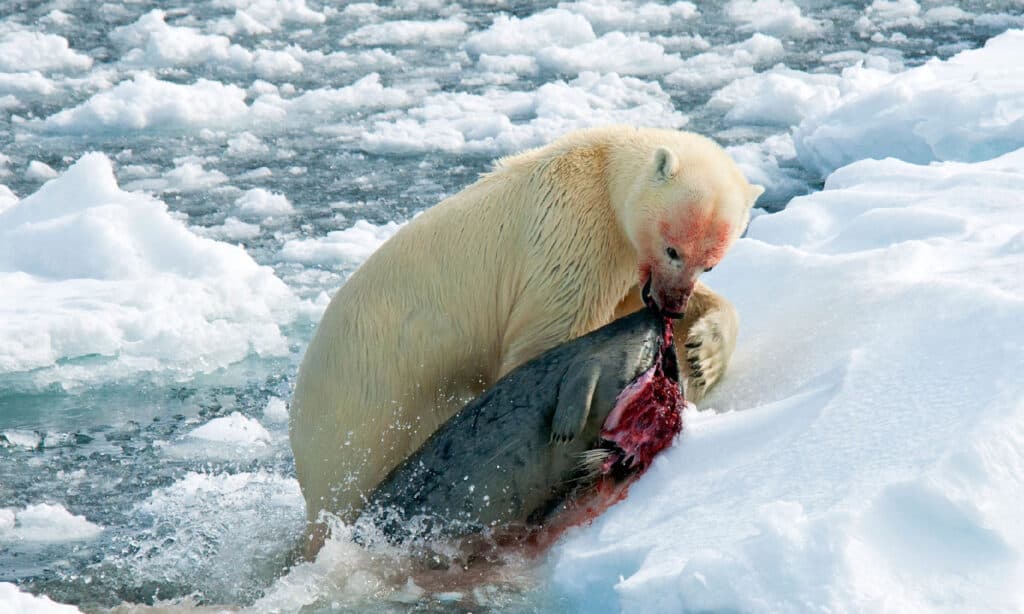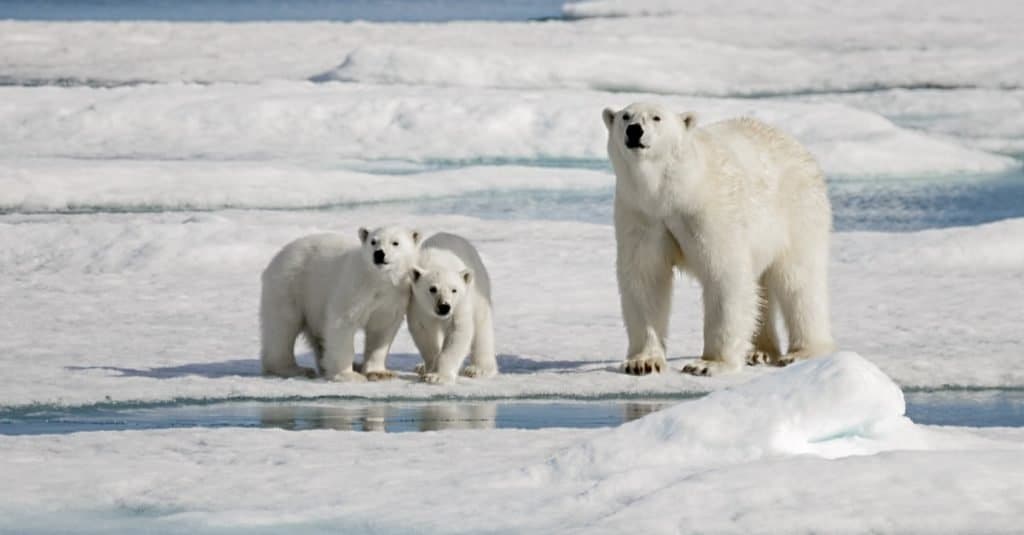Polar bears need sea ice for hunting, reproduction, and to move over large Arctic areas. Without adequate sea ice, this species must change and adapt in sometimes harmful ways. According to recent research, polar bears must spend more time fasting and they produce fewer cubs when faced with declining ice. Decreasing sea ice may threaten the very survival of this species. Let’s take a closer look at why sea ice is so important to polar bears.
Ice Supports the Food Chain

Without ice, the food chain that polar bears depend on would collapse.
©Ondrej Prosicky/Shutterstock.com
Polar bears are an almost exclusively carnivorous species. Although other bears regularly eat plant materials such as fruits or berries, polar bears only consume very limited amounts of vegetation, such as kelp. They rely on prey such as seals and small whales as their primary food source. They may also eat moose, reindeer, small mammals, sea birds, and fish if they cannot get enough of their preferred prey.
The seals and whales that polar bears eat consume mainly Arctic fish. These fish eat smaller creatures that live in the cold sea, and those creatures mainly consume algae that grow on the bottom of the ice in the sea. This food chain falls apart without the ice that supports the algae. Where abundant sea ice exists, other creatures follow, drawing larger and larger predators. Polar bears need this ice, and the food chain that leads to their favorite prey, to survive.
Ice Provides Hunting Platforms

Polar bears depend on ice when hunting their favorite foods, seals, and small whales.
©iStock.com/AGAMI stock
Polar bears would have a much harder time catching seals and small whales if they had to wade into the sea from rocky shorelines. The sea ice makes hunting a considerably easier task. This species uses ice platforms to catch their prey by surprise. The seals that they love best must surface for air at gaps in the ice. Polar bears often simply stake out the gaps near where seals make their dens and just wait. Sometimes they use the ice platforms as a place to dive into the water and catch prey off guard. Either way, the ice is essential to the hunting success of these bears.
Polar Bears Can’t Travel Far Without Ice
Without the sea ice, polar bears can’t travel far. They depend on the ice to help them get back and forth across large distances. Land, in the Arctic, is largely separated by water. Without ice, this disjointed landscape would prove impossible to navigate for all but sea dwellers. With thick sea ice, polar bears can travel far and wide, migrating to their favorite hunting grounds and making their way safely back to their summer haunts.
Ice Is Necessary for Reproduction

Polar bear mothers depend on ice to den and give birth to their cubs.
©Alexey Seafarer/Shutterstock.com
Without adequate sea ice for hunting, female polar bears may not get enough to eat. And without enough food, they will have reduced reproductive success. Polar bear mating season takes place in the spring, from April through June. But these bears reproduce through delayed implantation, meaning the fertilized eggs do not implant in the uterus until sometime in the fall. Implantation only occurs if the female polar bear has packed on enough weight and her body is ready to sustain the pregnancy and raise the cub or cubs. She will have to do this all without sustenance as she lives in her den through the winter. If she has not eaten well enough to prepare over the summer and early fall, the fertilized eggs will not implant.
Ice Helps Provide Protection
One more reason that polar bears need ice involves the protection of their cubs. Pregnant polar bears often dig dens in the ice, and as fresh snow falls, it covers the entrance to the den. This provides a cozy and hidden space where the female can rest and give birth to her cubs. These well-camouflaged, icy dens help protect the mother and her cubs from both the weather and male bears. They also prevent any potential predators from intruding. White polar bears and their cubs nearly disappear against the icy landscape as they emerge from their dens. This material is perfect in so many ways for protecting and sheltering polar bear mothers and cubs.
Declining Sea Ice Puts Pressure on Polar Bears
Numerous studies indicate that climate change is negatively affecting the ice pack in the Arctic Circle, and declining sea ice causes a number of problems for this species. Even in places where ice still covers the sea, if its thickness decreases it can make life difficult for the species. Polar bears can spend time on land, but to truly thrive, they need months at a time on ice.
The photo featured at the top of this post is © iStock.com/Alexey_Seafarer
Thank you for reading! Have some feedback for us? Contact the AZ Animals editorial team.







